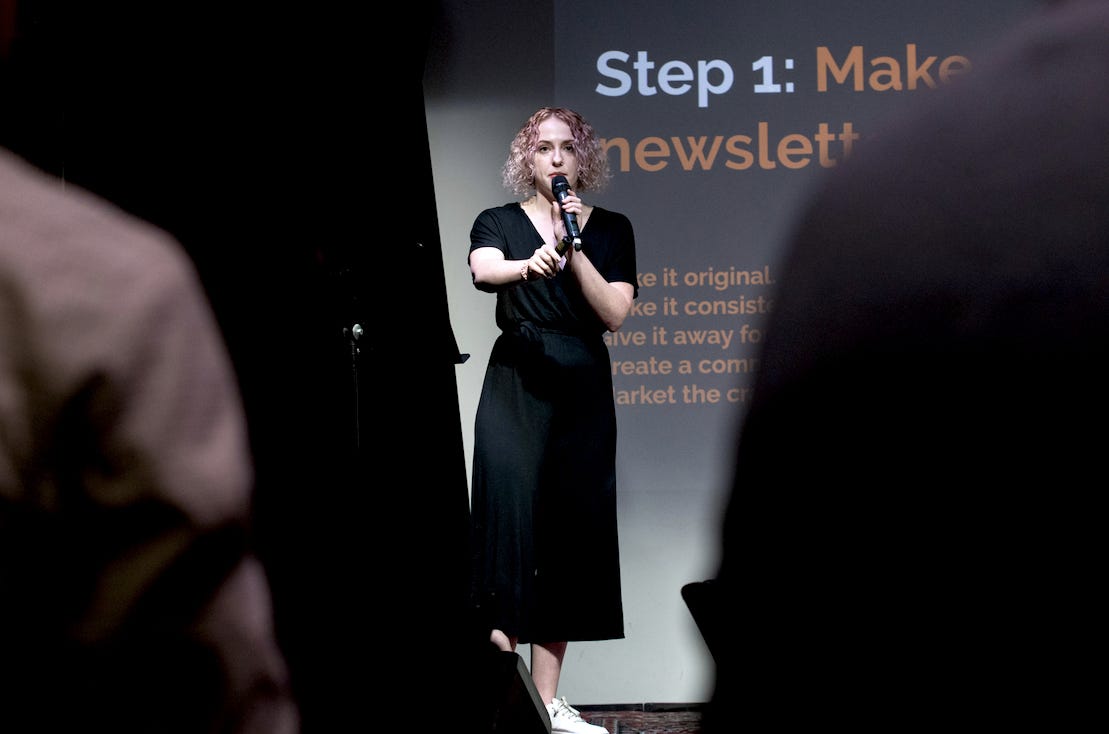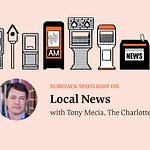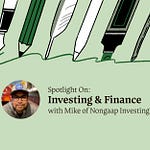
We invited Emily Atkin, author of Heated, to talk to an audience of Substack writers in New York about how she successfully launched paid subscriptions. Emily left her job at The New Republic to start Heated, which offers original reporting and analysis on the climate crisis. Her newsletter is now her full-time job, bringing in six figures of revenue.
This transcript has been lightly edited for readability.
Takeaways
Focus on building your free signup list first.
Announce a paid launch date.
Offer a discount for early birds.
Every day during your launch week, give people a different reason to subscribe.
A day before your first paid post, make a final pitch.
I write a newsletter called Heated. It’s been in existence for five months now, and it’s going well. It’s my full-time endeavor.
Being able to make a living off my writing has always been my dream since I was in college and I took my first journalism class. Eight years and a lot of failures later, Substack provided me with a platform to be able to succeed. It’s honestly allowed me to achieve my dream. I make more money now than I had at any salaried journalism job.
I make more money now than I had at any salaried journalism job.
I’m going to talk about how to grow your free newsletter into a paid newsletter. At this point, you’ll already have had a newsletter for a while. You’ll have enough subscribers that you think you can convert some to paying. You’re ready to go.
I’m going to share the tactics I used. You can adapt these however you like. I only launched my paid newsletter a little over two months ago, and I’m already in the six-figures range. I’m not a genius; I just followed a formula.
Make your newsletter free for as long as you can
Step one is to make a free newsletter, and make it original. Make it consistent. I think consistency is really important; that’s something I’ve heard from a lot of my subscribers. I have a little over 20,000 signups on my free list and a little over 2,000 on my paid list, including subscriptions I’ve given away.
Give your newsletter away for free for as long as you possibly can. Especially if it’s getting a lot of traction off the bat, and people are like, “I would like to pay you for this. Can I pay you for it?” Don’t let them. Hold on for as long as you possibly can, because almost all the paid subscriptions you’ll get will be conversions from your free list.
People don’t just sign up and pay. They want free content first, so they can decide if they want to pay. From my analysis, the average amount of time that people take to convert from free to the paid list is about a month, although I don't have much data yet.
Give your newsletter away for free for as long as you possibly can. People don’t just sign up and pay. They want free content first.
Foster your community. Make people want to pay for your stuff. Market your newsletter in a way that will almost make you uncomfortable, because it sounds like you're just talking and promoting yourself all the time.
Announce you’re going paid
So you've done all that, and you're ready to launch your paid subscription. Don't just put a paywall up. Give your readers at least a week's notice.
I write my newsletter four days a week, Monday through Thursday. So, two weeks before I put up a paywall, I said, “Okay, guys. Now's the time. It's been three months. Next week, I'm going to give you the ability to pay.”
I wrote that on the bottom of a Thursday newsletter, the last one of the week. I told my readers that I've written this newsletter for free because I wanted to demonstrate its value first. I said that next week, I’ll start accepting payments, and I'll announce the rates then, but it’ll still be free all of next week.
Once you turn on payments on Substack, the format changes. You unlock the ability to write preambles to your newsletter. That's where I did my marketing. I went personal on it. I was like, “Guys, I'm scared. I quit my job to do this. Please don't let me fail.”
That's another thing about newsletters. You can get personal. I did some positive marketing for this, too. I was like, “If this works, imagine how many more people we can reach; if I can hire a research assistant; if I had a copy editor...”
Kick off a paid launch week
The next week is your paid launch week, where you remind people every day that you’re going paid, but you still keep all your content free.
Make sure your content is really good all week. Put in extra work. Every day, in your preamble, try to give a different reason why people should subscribe.
Set your price high – higher than you’d think. During your paid launch week, offer a discount. I did 25% off the first two days and then 20% off the second two days so I could say, “All right, you missed 25% off, but you still have 20% off”. Then the price goes up from there.
For day one, I focused on a personal appeal and giving a discount. I made it feel like: “Today’s a special day, cue the air horn sounds!” Especially after you've been giving stuff away for three months, you've built up a community, so it should feel like, “Yay, now it's your turn.”
I made a personal appeal there that was, “I gave this to you for free, but it's not sustainable for me. I want to be able to do this every day. I want this to grow. I have so many aspirations for this. We, together, can make this a thing. Let's make it a thing.” People are like, “Yeah, let's make it a thing!”
I also do this thing where for every 100 people who sign up, I'll give 10 subscriptions away to people who need it. It helps. It's good because it helps grow your paid list, but it also gives your stuff to people who can't afford it. People are like, “Oh, okay, if I can afford it, I’d also like your writing to go to somebody else.”
For day two, I used the excitement from day one for momentum. You can send different emails to your free and paid list. So I sent an email to those who’d paid on day one that was like, “Guys, you signed up. Yes. Thank you so much. You're amazing.”
Then I sent an email to my free list that said, “If you're getting this message, that means you didn't sign up. How dare you? After all I've done for you.” But then I said, “This is the last day you can get 25% off, so you're going to want to do it today.”
Build upon your momentum from day one. Include quotes from people on Twitter who are signing up for your newsletter, even if it's just one of your friends.
For the next two days, experiment with different tactics. You know your community, so you’ll know best what would appeal to them.
For day three, I tried this messaging about how the fossil fuel industry poured billions of dollars into disinformation. My newsletter is about climate change, but it's specifically about powerful people and climate change. So for day three, I used that angle. I was like, “Let's combat this with information. Let's produce journalism that makes the truth louder than their lies. That can only happen with your support.”
On day four, I didn't do any marketing. I just did an ‘Ask Me Anything’ [AMA]. I used the discussion threads feature on Substack, which is a way to interact with your subscribers. On that day, people had a lot of questions about the paid launch, so I was able to go in there and answer their questions.
I did five newsletters this week instead of my usual four, because I just wanted more opportunities to promote my launch. I decided to make my last day something big, to demonstrate the value of this work that your money would buy.
On the last day, I launched a project I had been working on for a long time. I published a large anthology of fossil fuel advertisements. There was an embargoed study in there, some interviews, all this stuff. Instead of having my marketing preamble at the beginning, this time I did it at the end. I said, “This is an ongoing project. There's so much we're going to do, but it can only happen with your support.”
Make your final pitch
By the end of this week, you've asked people to pay you every single day. It’s now the weekend. Take a break.
The last thing that happens is to make your final big pitch. For me, this was the Monday after my paid launch week.
This will be the last time your newsletter is free. After my final pitch, I put up a paywall, and now 75% of my content is paywalled. I told my readers that after three months, this will be the last time you're going to get it.
Write a post explaining everything that you've accomplished while your newsletter was free. If you’re thinking about going paid, you should always keep a list of every good thing that has happened, like getting a nice email, a good tweet, seeing your work cited in another publication – just any way you can say you've been influencing the conversation or making people feel good. You want to be able to say, “This newsletter is original in this way. Nothing else like this exists.”
Write a post explaining everything that you've accomplished while your newsletter was free. You want to be able to say, “This newsletter is original in this way. Nothing else like this exists.”
That's what I put into my final pitch. I showed what I’d accomplished in the past three months. I had sections about how this reporting is making a difference, how it’s shifting the national conversation, where it's been cited. Every amount of praise that has ever happened, I put into one place. “Vox called it great. Earther called it wonderful. Environmental Health News called it a unique blend of insight and smartass.”
Back when my newsletter was still free, I’d done a survey where I asked people to tell me why they liked the newsletter. I compiled that into a spreadsheet and used it for marketing. I was able to say things like, “Six people said that they felt less alone when they read this newsletter. It's helping you guys feel better, and that's what makes me feel better. So let's keep this going.”
Your first and your last pitch are the days where you’ll get the most subscribers. The first day you launch, you get a lot. The second day, especially if you do a two-day discount, you get a lot. Third and fourth day, you're like, “Uh-oh, it's over.” And then on the final day, you’ll get a lot.
The final step is to put up your paywall. After you do that, your daily audience will become much smaller. At that point, I probably had 18,000 free signups. All of a sudden, with my paid subscribers, it's 1,000. For the majority of the week, I'm now writing for a much smaller audience, which is actually way easier, because they like me enough to have paid me.
After launch week is over, you might panic because you think it's all over and no one will ever pay you again. But just keep that process going. Every time you have a free newsletter, try to say something to encourage people to go paid.
How do you know if you’re ready?
You might be asking yourself, “Am I ready to launch?” So I came up with a list of considerations that might help you decide:
How many free subscribers do you have? Conversion rates tend to be around 4 to 10 percent, according to other Substackers I’ve talked to. If your free list isn’t very big, consider waiting.
How much money do you want to charge? Have you asked your subscribers what they’re willing to pay, or looked at similar newsletters to yours?
What impact have you made that you can point to? People like knowing they’re supporting something meaningful. Have you asked your readers for feedback?
What makes you original and worth paying for? Before you launch paid, you should feel really comfortable saying why your thing is different than anybody else's thing and why it should exist. You’re going to have to make your case and do a lot of shameless self-promotion around it. It’s going to be awkward. Get over it.
If you have a highly specialized niche audience, you might be ready. That means people who like you, really like you. Some of the best advice I got was that you don't have to please everybody, but you have to please some people a lot. Not everybody has to like you, but a small amount of people have to really like you.
Your impact doesn't have to be big. Use language to make a small impact seem bigger. We were cited in this local paper with a circulation of 20,000. That might not feel big to you, but people like to feel like they're part of something. That's why the newsletter model works. Your readers want to feel like they're part of this community that's growing and making a difference.
The most important question, though, is: Do you feel ready?
The most important question, though, is: Do you feel ready? This process is really different for everybody. Since starting my newsletter, I've talked to many other Substack writers who are going through this, and their newsletters and communities are so different from mine. Their subject matter is different. Not everyone is a reporter. Some of us do creative writing. Some of us compile links. We all have different communities.
In the end, I feel like you'll just know. Even if you're scared, you'll have a gut feeling that you think it might be time, and you might be willing to make it work. Just trust that feeling, because that's what I did, and I'm still winging it.
For more advice on launching a paid publication, check out our guide to going paid.












Share this post